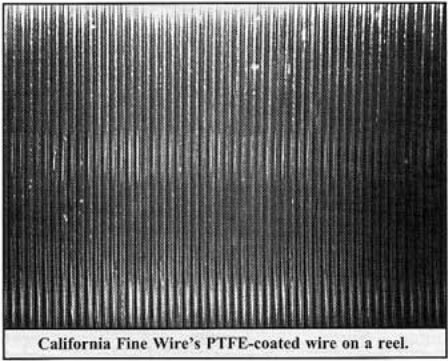Mike Greenelsh, President
California Fine Wire, Inc.
338 &. 4th Street, PO Box 446
Grover Beach, CA 93483 USA
www.calfinewire.com
A few good ideas just keep on get-ting better, leading to one application after another, continuously generating major improvements to our products and the quality of our lives.
One of the most productive and en-during of such ideas is the polymer polytetraflourocthylene (PTFE). Possessing some of the most amazing yet commonly sought-after properties in modern science, PTFE-coated wire adds to performance, durability and safety in many product categories, saving many manufacturers and users many millions of dollars a year.
PTFE’s money, time and life saving properties have become critical for product engineers throughout industry. Yet, surprisingly, many of them appear to be aware only of a few of PTFE’s traditional uses and might benefit enormously from a more complete awareness of PTFE’s unique properties and its use with products in diverse industries.
PTFE Properties
Asa material, PTFE has an amazing range of properties that are ideal for use throughout aerospace, communications, electronics, industrial processes, medicine, packaging and specialty films.
These properties include chemical and biological inertness, a very low co-efficient of friction, excellent performance at extreme temperatures, weather/UV resistance and resistance to moisture absorption.
The need for one or more of these properties has made PTFE increasingly indispensable throughout science and industry.
But there is always room for more innovative uses, which could be worth millions of dollars in profits or production and design cost savings or even less consumer litigation due to premature product failure.
PTFE is still the “slipperiest” substance, with an exceedingly low coefficient of friction in the range of 0.05 to 0.20, depending on speed and load. When you consider this property as a sort of built-in, ultra-high “lubricity,” you begin to think way beyond non-stick applications. PTFE-coated wires are of-ten used in areas where lubricity 1s very important.
A good example of the use for this lubricity is the miles of cables and other types of wire installed on board aircraft for electronic controls.
Even though such cables would usually not be required to move back and forth underneath the skin of the aircraft, there is always a relatively severe vibration factor during flights, and the PTFE coating can overcome resulting abrasion or chaffing of cables and terminals.
Many Applications
There are no doubt many other applications that would benefit from the lubricity that is inherent to PTFE coatings, including military vehicles, spacecraft and other high-speed equipment, or wherever abrasion is a problem. PTFE is quite inert, meaning that chemical and bio-logical agents don’t react with it, This makes it quite useful In medicine, especially where invasive surgery is performed or devices are left in-side the anatomy of a human or animal.
Because PTFE is chemically inert, the physiology of humans and animals is not prone to “rejecting” it. Medical applications for PTFE-coated wire and other materials are quite widespread. If your product can benefit from high dielectric strength, using a PTFE coating may offer the required insulation. PTFE offers a dielectric strength of up to 5000 VY or more depending upon the thickness of the coating, another reason it will serve as a good coating for probes and sensors used by the medical COMMUNITY, just as it is today for pace-maker wiring.
Another of PTFE’s major properties is that it resists absorption, and therefore offers resistance to corrosion from virtually all chemicals. For this reason you will find PTFE-coated wires used in harsh chemical environments.
If cold temperature is a consideration, PTFE will operate at-270°F (-168°C), This makes it especially applicable to instrumentation products that have to operate in extremely cold weather or cryo-genic applications including use in thespace program.
Conversely, PTFE will withstand heat up to 500°F (260°C), making it an excellent insulator for electronics such as thermocouples that often work in very hot environments.
Summary
So when engineers look at all the properties and attributes of PTFE in light of products they are designing or have in production, the possibilities really become exciting.
PTFE may not be a new material, but from our perspective few others are as versatile or hold more promise when it comes to providing innovative solutions for a wide range of industries.
Overlooking it in the design process could cost you big money.
For more information on PTFE wire, contact the author or Cirele 207.
Company Profile…California Fine Wire, Inc. manufactures fine and ultra-fine wire in as many as [000 combinations of metals
and alloys. Hire processing operations include drawing, straightening, culling, annealing, enameling, respooling, shaping, stranding, brazing and soldering. Finished products include wire, cables, alloys, clad wire and composite wire.


